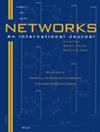论最大覆盖位置问题升级版的复杂性
IF 1.3
4区 计算机科学
Q4 COMPUTER SCIENCE, HARDWARE & ARCHITECTURE
引用次数: 0
摘要
在本文中,我们研究了网络上最大覆盖位置问题升级版的复杂性,该问题的边长有修改。在一般网络上,这个问题是 NP 难的。然而,在某些特殊情况下,我们证明这个问题可以在多项式时间内求解。我们分析了星形网络和路径网络的情况,并结合了对模型参数的不同假设。特别是,我们得出星形网络上的问题对于均匀权重可在 O(nlogn)$$ O\left(n\log n\right) $$ 时间内求解,而对于非均匀权重则是 NP-hard。在路径上,单一设施问题可在 O(n3)$$ O\left({n}^3\right) $$ 时间内求解,而 p$$ p$ 设施问题即使有统一的成本和上限(每条边的最大升级)以及整数参数值,也是 NP-hard。此外,还针对具有整数参数的树上单一设施问题开发了一种伪多项式算法。本文章由计算机程序翻译,如有差异,请以英文原文为准。
On the complexity of the upgrading version of the maximal covering location problem
In this article, we study the complexity of the upgrading version of the maximal covering location problem with edge length modifications on networks. This problem is NP-hard on general networks. However, in some particular cases, we prove that this problem is solvable in polynomial time. The cases of star and path networks combined with different assumptions for the model parameters are analysed. In particular, we obtain that the problem on star networks is solvable in time for uniform weights and NP-hard for non-uniform weights. On paths, the single facility problem is solvable in time, while the -facility problem is NP-hard even with uniform costs and upper bounds (maximal upgrading per edge), as well as, integer parameter values. Furthermore, a pseudo-polynomial algorithm is developed for the single facility problem on trees with integer parameters.
求助全文
通过发布文献求助,成功后即可免费获取论文全文。
去求助
来源期刊

Networks
工程技术-计算机:硬件
CiteScore
4.40
自引率
9.50%
发文量
46
审稿时长
12 months
期刊介绍:
Network problems are pervasive in our modern technological society, as witnessed by our reliance on physical networks that provide power, communication, and transportation. As well, a number of processes can be modeled using logical networks, as in the scheduling of interdependent tasks, the dating of archaeological artifacts, or the compilation of subroutines comprising a large computer program. Networks provide a common framework for posing and studying problems that often have wider applicability than their originating context.
The goal of this journal is to provide a central forum for the distribution of timely information about network problems, their design and mathematical analysis, as well as efficient algorithms for carrying out optimization on networks. The nonstandard modeling of diverse processes using networks and network concepts is also of interest. Consequently, the disciplines that are useful in studying networks are varied, including applied mathematics, operations research, computer science, discrete mathematics, and economics.
Networks publishes material on the analytic modeling of problems using networks, the mathematical analysis of network problems, the design of computationally efficient network algorithms, and innovative case studies of successful network applications. We do not typically publish works that fall in the realm of pure graph theory (without significant algorithmic and modeling contributions) or papers that deal with engineering aspects of network design. Since the audience for this journal is then necessarily broad, articles that impact multiple application areas or that creatively use new or existing methodologies are especially appropriate. We seek to publish original, well-written research papers that make a substantive contribution to the knowledge base. In addition, tutorial and survey articles are welcomed. All manuscripts are carefully refereed.
 求助内容:
求助内容: 应助结果提醒方式:
应助结果提醒方式:


